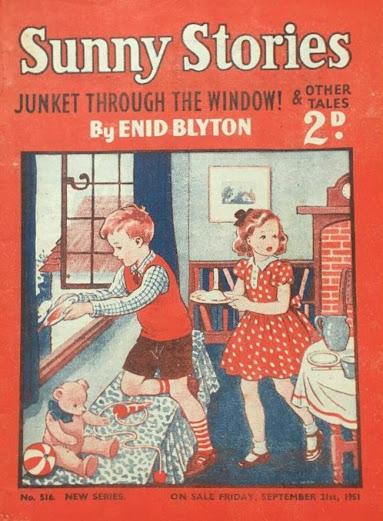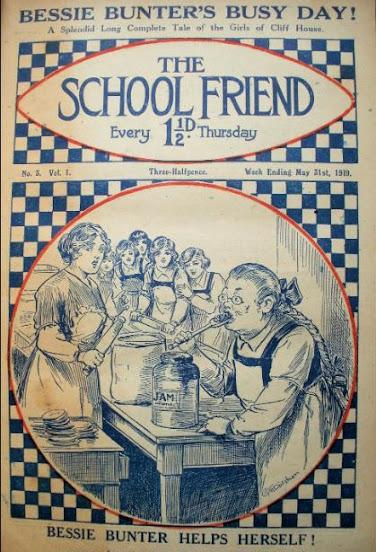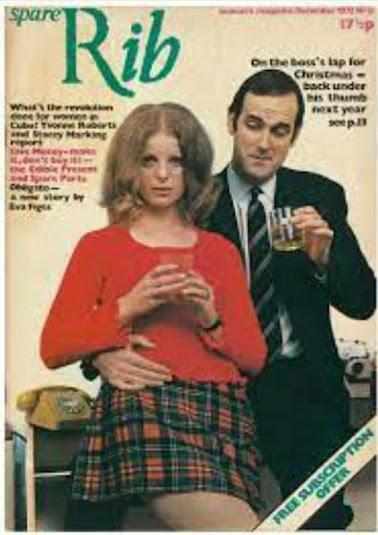
In the early days of ‘Bunty’ and ‘Girl’, we were lucky to have them delivered with the newspaper and I only had to make the effort when I wanted to read 'Dandy' and 'Beano' which weren’t thought suitable, so I had to go to the shop to buy them. My favourites were the school stories and the girls' wonderful times at boarding school so I remember ‘The School Friend’ which looking at copies Online now are really well presented but from all points of view ‘not politically correct’. In them was an escape from my basic boring Comprehensive school of everyday things to a wonderland in a mysterious old house or mansion where you could be with a group of pals who had adventures and afternoon tea served to them. Sometimes they dressed up in gowns and masks as’ The Silent Three’ to right a wrong. It was very moralistic with honor for the school and each other. I loved the names Polly Linton and Betty Barton, Cora Grandways was a troublemaker. 'The School Friend' was published by Amalgamated Press as a story paper for girls from 1919 to 1929, renamed The Schoolgirl and continued to1940, revived as a comic in 1950 as a mix of comic strips and prose stories published by AP, then Fleetwood and IPC .In 1965 it merged into ‘ June and Schoolfriend’ edited by Mavis Miller. Some original titles were: The Gypsy Schoolgirl The Heroism of Phillipa Derwent The Girl who Deceived the Form Bessie Bunter’ s Busy Day
 This was supposed to be the correct way to think and mostly went unchallenged. As a young adult let loose from the claustrophobia of home there were so many versions of life shown in the monthly editions and as for the top shelf men’s mags!The American edition of 'Cosmopolitan' was a find and much better than the later British version but returning to the 70’s there was ‘Spare Rib’. This was serious stuff, not the sitting down with a packet of chocolate digestives to while away an hour, material. This magazine was founded in 1972 in the U.K. to shape debate about feminism, challenging stereotypes with a jokey title referring to the Biblical reference of Eve who was the first woman created from Adam’s rib and showing there was no independence for women from the beginning of time. The first issue was distributed by Seymour Press but W.H. Smith refused to stock it because it had an expletive on the back page! Later it was distributed to a network of radical and alternative bookshops.
This was supposed to be the correct way to think and mostly went unchallenged. As a young adult let loose from the claustrophobia of home there were so many versions of life shown in the monthly editions and as for the top shelf men’s mags!The American edition of 'Cosmopolitan' was a find and much better than the later British version but returning to the 70’s there was ‘Spare Rib’. This was serious stuff, not the sitting down with a packet of chocolate digestives to while away an hour, material. This magazine was founded in 1972 in the U.K. to shape debate about feminism, challenging stereotypes with a jokey title referring to the Biblical reference of Eve who was the first woman created from Adam’s rib and showing there was no independence for women from the beginning of time. The first issue was distributed by Seymour Press but W.H. Smith refused to stock it because it had an expletive on the back page! Later it was distributed to a network of radical and alternative bookshops.  It had to have the ‘look’ of a woman’s mag but it’s purpose was to investigate and present alternatives to the traditional roles of virgin, wife and mother and to set the record straight on Women’s Liberation by reaching out to all women. It ceased publication in1993 as there were splits in thinking. 'Spare Rib' is recognised as iconic today in the U. K and was digitised by the British Library in 2016. It remains one of the Women’s Liberation movements most notable achievements. There are too many magazines to do them justice here but they have featured over many decades of my life. Sorry, can’t find a poem for this and thank you for reading.
It had to have the ‘look’ of a woman’s mag but it’s purpose was to investigate and present alternatives to the traditional roles of virgin, wife and mother and to set the record straight on Women’s Liberation by reaching out to all women. It ceased publication in1993 as there were splits in thinking. 'Spare Rib' is recognised as iconic today in the U. K and was digitised by the British Library in 2016. It remains one of the Women’s Liberation movements most notable achievements. There are too many magazines to do them justice here but they have featured over many decades of my life. Sorry, can’t find a poem for this and thank you for reading.Cynthia Email ThisBlogThis!Share to TwitterShare to Facebook
